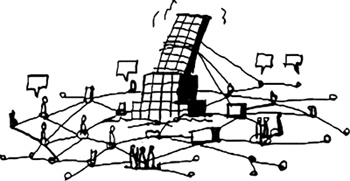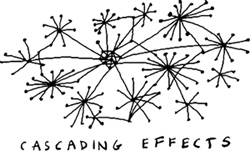If you make customers unhappy in the physical world, they might each tell six friends. If you make customers unhappy on the Internet, they can each tell 6,000 friends.
Customers are connecting, forming networked communities that allow them to rapidly share information and self-organize into powerful interest groups. Companies will have to be more responsive to customer needs and demands if they want to survive.
The balance of power is shifting from companies to the networks that surround them. Connected, communicating customers and employees have more choices, and more amplified voices, than ever before. They have more knowledge than ever before. These trends are only increasing with time. This means the network—customers, partners, and employees—will increasingly set the agenda, determine the parameters, and make the decisions about how they interact with companies.
In February 2007, Starbucks chairman Howard Schultz sat down to write a difficult memo.
Schultz, always in the habit of visiting stores around the world, had noticed that the Starbucks experience was deteriorating. And in 2006, Starbucks’ legendary growth had started to slow. The amount of money customers were spending was starting to dip.
In his 2007 memo, “The Commoditization of the Starbucks Experience,” Schultz laid out his concerns. Espresso machines, which increased efficiency, were too tall; they created a wall that blocked the line of sight between customers and baristas, a barrier to conversation and connection. Flavor-locked packaging, which guaranteed fresh roasted coffee in every cup, also made the stores more antiseptic, depriving them of their rich, flavorful, coffee aromas. Streamlining store designs increased efficiency, but many customers perceived them as sterile, cookie-cutter designs.
“We have all been part of these decisions,” wrote Schultz. “I take full responsibility myself, but we desperately need to look into the mirror and realize it’s time to get back to the core and make the changes necessary to evoke the heritage, the tradition, and the passion that we all have for the true Starbucks experience.”
The memo was meant to be a wake-up call to the senior executive team as they embarked on their yearly strategic planning process. But it soon became much more than that. A little over a week later, a colleague stepped into Schultz’s office. “Someone leaked the memo,” he said. “It’s on the internet.”
Reporters were already calling, but Schultz was too shaken up to grant any interviews. This had been a confidential memo to the CEO and a small group of senior executives in the company. He couldn’t believe any of them would have done such a thing.
The memo had first appeared on a blog called Starbucks Gossip and was quickly picked up by the mainstream media. The speed at which word spread, and the breadth and depth of the online conversations that ensued, astonished Schultz:
The day after the memo was posted, the mainstream media picked it up like a whirlwind. The Wall Street Journal. The New York Times. The Associated Press. Bloomberg, Reuters, the Financial Times. Online financial news sites and independent blogs. Articles quoted the memo and parsed my words, usually under dour headlines that implied, or stated outright, that trouble was brewing at Starbucks. Online, readers posted comments one after the other. Many of them stung. Stunned as I was that the memo had been leaked, I was also astonished by the depth of conversation it unleashed, as well as the speed. It seemed that everyone—customers, partners, analysts, reporters, industry insiders, and business “experts”—had an opinion about the memo, its motive, what it meant for the future of the company as well as what it said about me as a leader.
Schultz says he took two very important lessons from his experience. First, nothing can be presumed confidential. Second, Starbucks did not have a voice in the global conversation:
The heated online conversations about the memo were beyond Starbucks’ influence, more so than any other controversy we had experienced…the good things about us, our values and the acts that distinguished us, these were getting lost in the public conversation. The millions of dollars we invested in local communities. The health-care coverage and stock we extended to part-timers, at a considerable cost to the company. While we never put forth press releases about many of these initiatives—believing they were just the right things to do—we also were not getting credit for them…
Our website, with its beautifully designed pages…was primarily a one-way dialogue, inadequate in the digital age. Starbucks had no interactive presence online. No way to speak up quickly on our own behalf, to talk directly to customers, investors, as well as partners, or let them talk directly to us…we were losing control of our story, in the stores as well as the real world.
The leaked memo and its aftermath were a wake-up call for Schultz. “I was not sure where to begin,” he writes today, “but we had to do something.”
If Starbucks didn’t have a voice in the global conversation, who did? The Starbucks Gossip blog, the mainstream media, readers, customers, analysts, and so on—in other words, anyone and everyone who was interested: the network. And because the memo was interesting, it cascaded through the network, gaining momentum as it went, like a tidal wave.
These kinds of cascading effects are common in networks. An initial event strikes a chord: it’s interesting, funny, sad, disgusting, or enraging. As a result, it is shared, commented on, analyzed, and argued about. And as it moves through the network, it is amplified, sometimes to an exponential degree.
In 2005, Dell learned a tough lesson when they shut down peer-to-peer customer forums, and Dell customer (and blogger) Jeff Jarvis, who had recently bought a machine that almost immediately malfunctioned, expressed his dissatisfaction on the Web in a post titled, “Dell lies. Dell sucks.” Jarvis coined the term “Dell Hell,” saying Dell didn’t “respect [customers] enough to listen to them.”
Within a week, Dell Hell was a story in The New York Times and Business Week. Hundreds of other bloggers chimed in to tell their “Dell Hell” stories. At the time, Dell had an internal policy not to reply publicly to blogs. So the company remained silent, and the PR nightmare snowballed. Sales plummeted, along with Dell’s reputation.
Dell has learned from its mistake, and in 2010 launched a “customer listening command center” to monitor and proactively respond to online conversations. Founder and CEO Michael Dell is active on social media, engaging with customers directly.
In another incident, Canadian musician Dave Carroll was traveling on United Airlines in 2008 and had checked his guitar into baggage, when his plane landed at Chicago’s O’Hare airport en route to Omaha. He became concerned as he watched baggage handlers on the runway throwing guitars. When he arrived in Omaha, he found that indeed the neck of his $3,500 Taylor guitar had been broken. He filed a claim with the airline, but they refused to honor it because he had failed to make the claim within 24 hours. For nine months, he tried to negotiate with the airline. Finally, in frustration, he wrote a song titled “United Breaks Guitars” and released a music video on YouTube. The song’s refrain: “I should have flown with someone else, or gone by car, ‘cause United breaks guitars.”
The video was an Internet hit. Within one day of its release, it had amassed 150,000 views. In a few weeks, that number had risen to 5 million, and in December, Time magazine listed it as number 7 on a list of top viral videos of 2009.
Once the video was released, United contacted Carroll to try to right the wrong, but it seems that their efforts were too little, too late. Bob Taylor, owner of Taylor Guitars, gave Carroll two free guitars, and Carroll refused compensation from United, asking instead that they revise their customer service policies and give the money to charity. United donated $3,000 to the Thelonious Monk Institute of Jazz as a gesture of goodwill, but by that point, the damage had been done.
In 2009, two Dominos workers videotaped themselves doing disgusting things to food—one put cheese up his nose and mucus on sandwiches while the other narrated—and they posted the video on the internet. One of the employees, who identified herself as Kristy, said, “In about five minutes it’ll be sent out on delivery where somebody will be eating these, yes, eating them, and little did they know that cheese was in his nose and that there was some lethal gas that ended up on their salami. Now that’s how we roll at Domino’s.”
Within the week, the video had garnered over a million views. “We got blindsided by two idiots with a video camera and an awful idea,” said Dominos spokesman Tim McIntyre to The New York Times .
Kristy Hammonds, 31, later said in a company email that it was just a joke and that she was sorry. But the damage had been done.
In March 2011, conservative activist James O’Keefe, posing as a member of a Muslim education group, secretly videotaped NPR fundraising chief Ron Schiller saying republicans were “racist” and “xenophobic,” and that NPR didn’t need federal funding. Schiller resigned and the CEO was forced to step down shortly thereafter.
On June 30, 2011, tech blog The Boy Genius Report published an anonymous memo from an executive at Blackberry maker Research in Motion (RIM), addressed to the RIM Senior Management team, starting with the words, “I have lost confidence. While I hide it at work, my passion has been sapped.” The letter went on to plead for drastic changes.
The company issued an official reply, saying, “It is particularly difficult to believe that a high-level employee in good standing with the company would choose to anonymously publish a letter on the web rather than engage fellow executives in a constructive manner…RIM is nonetheless fully aware of and aggressively addressing both the company’s challenges and its opportunities.”
The Boy Genius Report published the response, but at the same time also published more anonymous letters from RIM employees supporting the original memo and accusing RIM of poor leadership, leading to low morale throughout the company.
In September of 2011, Bank of America announced that it would start charging customers $5 per month to shop with their debit cards. In early October, a 27-year-old gallery owner in Los Angeles named Kristen Christian set up a Facebook event page, inviting 500 of her Facebook friends to move their accounts to local credit unions by November 5, which she called “Bank Transfer Day.”
“Together we can ensure that these banking institutions will always remember the 5th of November,” she wrote. “If we shift our funds from the for-profit banking institutions in favor of not-for-profit credit unions before this date, we will send a clear message that conscious consumers won’t support companies with unethical business practices.”
Christian’s groundswell movement quickly snowballed. Within three days, 8,000 people had signed up to attend the event.
“I was tired,” wrote Christian in another post. “Tired of the fee increases, tired of not being able to access my money when I need to, tired of them using what little money I have to oppress my brothers & sisters. So I stood up. I’ve been shocked at how many people have stood up alongside me. With each person who RSVPs to this event, my heart swells. Me closing my account all on my lonesome wouldn’t have made a difference to these fat cats. But each of YOU standing up with me…they can’t drown out the noise we’ll make.”
By November 4, the day before Bank transfer Day, at least 650,000 people had added $4.5 billion to credit union savings accounts. That same week, Bank of America dropped its plan to charge additional fees.
By changing the way we create, access, and share information, social networks are changing the power structure in society.
Customers like Kristen Christian can pick up a megaphone at any time, and if they have a message that resonates with the network, it can gain momentum very fast.
Rogue individuals can target you in sting operations, as James O’Keefe did, or they can simply act stupidly, as the Domino’s employees did.
Disgruntled employees can get their message out through leaks or anonymous memos like those from Starbucks and RIM.
However it happens, once something is released to a network, it can rapidly spin out of control.
Clearly, social networks such as Twitter and Facebook, which didn’t exist in 1999, have gained momentum far more quickly among the general population than they have in corporations. Customers are connecting and sharing information at a far faster rate than the companies that serve them. There’s no question that when it comes to social networking, companies lag behind their markets.
Networked customers can easily bypass formal channels to get information and support directly from each other.
Think about where you go when you want to make a buying decision today. In general, you go to peers first. If you want to go to a restaurant, you might go to Yelp! or Urbanspoon to read recommendations and reviews from customers. Booking a hotel? If you care about comfort and service, you might go to Hotels.com to read some reviews, or if price is a priority, you might go to Priceline, where you can set your own price. Want to watch a movie? You can find the best picks at Rotten Tomatoes, Netflix, or IMDB, where movie-watchers have a voice.
These peer-to-peer conversations subvert traditional marketing channels. Customers trust each other more than they trust companies, who have a vested interest in making themselves look good. A 2009 Nielsen study found that 90% of customers trusted recommendations from other customers more than any other form of advertising. And customers have begun to recognize, and exercise, their power.
This power, in and of itself, is not necessarily new. Customers have always had the power to choose what they wanted to buy. Customers and workers have always had the power to share their experiences with friends and peers. They have always had the power to promote—or demote—a company based on what it promised and what it delivered. Customers have always been able to vote with their wallets.
But they weren’t connected to a global network with the potential to amplify their opinions and experiences to hurricane strength. And that little thing we call “linking” makes all the difference.
Any dictator will tell you that in order to control the state, you must control the media. So ask yourself: who controls the media today? And which way are the trends heading?
In February 2010, a nonprofit organization called WikiLeaks began releasing classified cables between the US State Department and its consulates, embassies, and diplomatic missions around the world. It was the largest leak of classified material in the history of the world, and there was nothing the US government could do about it. Once information is released to a network, it can’t be pulled back. Wikileaks has demonstrated definitively that no secret, corporate or political, is safe for long.
We’ve been saying the customer is king so long that it has become a cliché. And in most cases, our actions don’t match those words. But customers will be kings and queens, not only in name, but in fact. One by one, customers are recognizing the power that comes from a world in which their choices are infinite and their voices are amplified. They are connecting. They are organizing. They are gaining mass and momentum.
Customers don’t need to revolt in an active way. All that is required is for a new company to come along and offer a better service. Connected customers will become aware of such services far more easily than they have in the past, and share the information more quickly, too. If the new service is interesting, it will quickly cascade through the network.
Some companies have figured out how to create these kinds of direct relationships. Amazon allowed customers to write negative reviews on the store’s website since the day they launched. That was a controversial decision at the time. Why would a retailer allow anyone to post information that would help a customer decide to not to buy something? Jeff Bezos recalls a publisher calling him and saying, “I don’t think you understand your business. You make money when you sell books.” But Bezos knew better. He understood that what connected customers value is a company that will help them make better buying decisions. And today we all understand that.
To think that this customer revolution won’t affect your business is naive. It will affect every business. It is already shifting the balance of power. It is changing the way power is controlled and exercised. It will change the way companies are organized and the way they do business.
Eventually, every customer will be a connected customer. And if you want to win over connected customers, you will need to become a connected company.
Get The Connected Company now with the O’Reilly learning platform.
O’Reilly members experience books, live events, courses curated by job role, and more from O’Reilly and nearly 200 top publishers.





